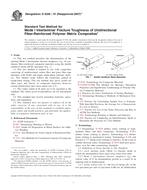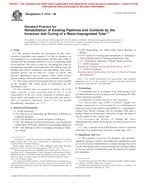1.1 These test methods cover the determination of the modulus and damping properties of soils in either undisturbed or reconstituted states by either load or stroke controlled cyclic triaxial techniques.
1.2 The cyclic triaxial properties of soil are evaluated relative to a number of factors including: strain level, density, number of cycles, material type, saturation, and effective stress.
1.3 These test methods are applicable to both fine-grained and coarse-grained soils as defined by the unified soil classification system or by Classification D2487. Test specimens may be undisturbed or reconstituted by compaction in the laboratory.
1.4 Two test methods are provided for using a cyclic loader to determine Young’s modulus (E) and damping (D) properties. The first test method (A) permits the determination of E and D using a constant load apparatus. The second test method (B) permits the determination of E and D using a constant stroke apparatus. The test methods are as follows:
1.4.1 Test Method A -This test method requires the application of a constant cyclic load to the test specimen. It is used for determining the Young’s modulus and damping under a constant load condition.
1.4.2 Test Method B -This test method requires the application of a constant cyclic deformation to the test specimen. It is used for determining the Young’s modulus and damping under a constant stroke condition.
1.5 The development of relationships to aid in interpreting and evaluating test results are left to the engineer or office requesting the test.
1.6 Limitations -There are certain limitations inherent in using cyclic triaxial tests to simulate the stress and strain conditions of a soil element in the field during an earthquake.
1.6.1 Nonuniform stress conditions within the test specimen are imposed by the specimen end platens.
1.6.2 A 90° change in the direction of the major principal stress occurs during the two halves of the loading cycle on isotropically confined specimens and at certain levels of cyclic stress application on anisotropically confined specimens.
1.6.3 The maximum cyclic axial stress that can be applied to a saturated specimen is controlled by the stress conditions at the end of confining stress application and the pore-water pressures generated during testing. For an isotropically confined specimen tested in cyclic compression, the maximum cyclic axial stress that can be applied to the specimen is equal to the effective confining pressure. Since cohesionless soils are not capable of taking tension, cyclic axial stresses greater than this value tend to lift the top platen from the soil specimen. Also, as the pore-water pressure increases during tests performed on isotropically confined specimens, the effective confining pressure is reduced, contributing to the tendency of the specimen to neck during the extension portion of the load cycle, invalidating test results beyond that point.
1.6.4 While it is advised that the best possible undisturbed specimens be obtained for cyclic testing, it is sometimes necessary to reconstitute soil specimens. It has been shown that different methods of reconstituting specimens to the same density may result in significantly different cyclic behavior. Also, undisturbed specimens will almost always be stronger than reconstituted specimens of the same density.
1.6.5 The interaction between the specimen, membrane, and confining fluid has an influence on cyclic behavior. Membrane compliance effects cannot be readily accounted for in the test procedure or in interpretation of test results. Changes in pore-water pressure can cause changes in membrane penetration in specimens of cohesionless soils. These changes can significantly influence the test results.
1.6.6 Despite these limitations, with due consideration for the factors affecting test results, carefully conducted cyclic triaxial tests can provide data on the cyclic behavior of soils with a degree of accuracy adequate for meaningful evaluations of modulus and damping below a shearing strain level of 0.5%.
1.7 The values stated in either SI or inch-pound units shall be regarded separately as standard. The values in each system may not be exact equivalents, therefore, each system must be used independently of the other, without combining values in any way.
1.8 This standard does not purport to address all of the safety problems, if any, associated with its use. It is the responsibility of the user of this standard to establish appropriate safety and health practices and determine the applicability of regulatory limitations prior to use.
Product Details
- Published:
- 12/10/1996
- Number of Pages:
- 15
- File Size:
- 1 file , 220 KB


